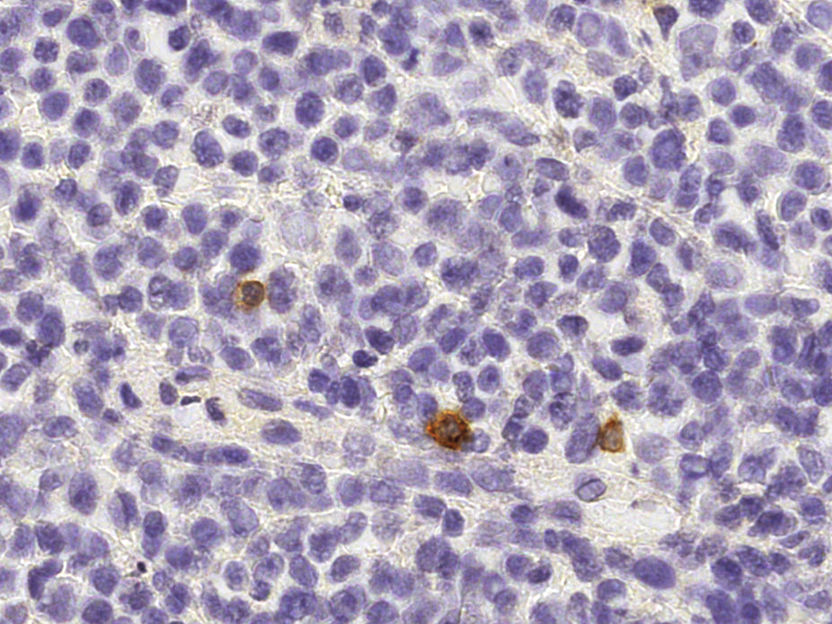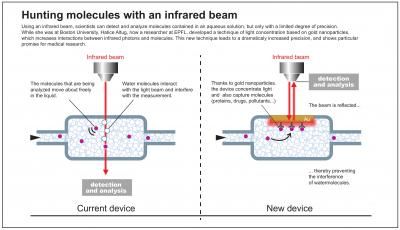Nanoparticles simplify DNA identification and quantification
In an article published in Small, researchers successfully applied a new qualitative and quantitative method for the detection of a DNA sequence characteristic of Leishmania infantum kinetoplast, a frequent parasite in veterinary that affects humans too. The work was led from the Catalan Institute of Nanoscience and Nanotechnology (ICN2), a research Center placed in the Campus of the Autonomous University of Barcelona (UAB) in Bellaterra, and the UAB Spin Off company Vetgenomics.
This work was coordinated at ICN2 by ICREA Prof Arben Merkoçi, Leader of the ICN2 Nanobioelectronics & Biosensors Group, and Dr. Alfredo de la Escosura-Muñiz (first author of the article) with collaboration of Luis Pires, PhD student from the same group. The work was carried out in collaboration with Prof. Armand Sanchez, Dr. Olga Francino, Dr. Laura Altet and Lorena Serrano from Vetgenomics. Their results are part of the bio-applications defined in the ICN2 Severo Ochoa Program "Devices for Social Challenges". The present work has been published within the POC4PETS European Project, coordinated by the Alma Mater Studiorum - Università di Bologna (Italy) and aimed to improving the speed and accuracy of current diagnostics for veterinary pathogens.
Overcoming the classical PCR technique
The Polymerase Chain Reaction (PCR) is today's standard method to identify the presence of a specific DNA sequence in a sample. The PCR uses enzymes and two primers, strands of short nucleic acid sequences that serve as a starting point for DNA copy. When the detection is positive, this technique produces millions of copies of the problem sequence to facilitate its detection. This DNA amplification involves precise thermal changes (thermocycling) and sophisticate and expensive equipment which are overcome by an alternative approach called isothermal amplification, performed at constant temperature.
In this context, the authors of the article present a novel design of isothermal amplification using primers labelled with both gold nanoparticles and magnetic microbeads. The amplified product carries both labels allowing a rapid purification and quantification. The magnetic properties of the first primer facilitate the purification/preconcentration of the amplified DNA through magnetic separation methods. On the other hand, the gold nanoparticles are easily quantified by simple electrocatalytic detection methods. Thus, the use of primers labelled with gold nanoparticles and magnetic microbeads turns isothermal amplification into a faster and easier qualitative and quantitative diagnostic method.
Nanoparticles for Leishmania detection and other point-of-care tests
This approach was successfully applied for the detection of a DNA sequence characteristic of Leishmania infantum kinetoplast, a parasite responsible of a disease in domestic dogs, wild canids and humans. The electrochemical method exhibited a good reproducibility and sensitivity. Furthermore, amplified DNA from dogs without Leishmania was perfectly discriminated, demonstrating the specificity of both the amplification procedure and the electrochemical detection. In fact, the performance of the proposed approach is better than the obtained with other point-of-care tests for Leishmania detection, offering also a quantitative tool for parasite determination. This method represents a universal methodology that could be applied for any isothermal DNA amplification design.
Topics
Organizations
Other news from the department science
These products might interest you

Eclipse by Wyatt Technology
FFF-MALS system for separation and characterization of macromolecules and nanoparticles
The latest and most innovative FFF system designed for highest usability, robustness and data quality

DynaPro Plate Reader III by Wyatt Technology
Screening of biopharmaceuticals and proteins with high-throughput dynamic light scattering (DLS)
Efficiently characterize your sample quality and stability from lead discovery to quality control

Get the life science industry in your inbox
By submitting this form you agree that LUMITOS AG will send you the newsletter(s) selected above by email. Your data will not be passed on to third parties. Your data will be stored and processed in accordance with our data protection regulations. LUMITOS may contact you by email for the purpose of advertising or market and opinion surveys. You can revoke your consent at any time without giving reasons to LUMITOS AG, Ernst-Augustin-Str. 2, 12489 Berlin, Germany or by e-mail at revoke@lumitos.com with effect for the future. In addition, each email contains a link to unsubscribe from the corresponding newsletter.
Most read news
More news from our other portals
See the theme worlds for related content
Last viewed contents
Reserpine
Economics_and_Human_Biology
Tetracapsuloides_bryosalmonae
Hermann_Johannes_Pfannenstiel
Cellular_respiration
Pastern
Glanzmann's_thrombasthenia
Smart_shop



















































